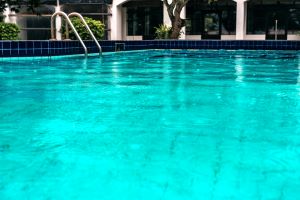
Outdoor pools are a major source of relaxation and enjoyment for homeowners; however, severe storms and hurricanes can cause a lot of damage to a pool, so if you own one, it’s vital to protect it from severe rain events and hurricanes.
Below are nine safety tips that will help you maintain your pool before and after a severe storm or hurricane:
Before the severe storm or hurricane hits:
- Do NOT drain your pool: When heavy rains raise the water table, the water in your pool provides weight to hold the bottom and sides in place for fiberglass and vinyl lined pools. If you empty your pool, you risk the possibility of lifting your pool’s foundation. Also, be sure to check the drainage around your pool. Test your drain to make sure that it’s able to accommodate water at a fast rate. If there are any clogs, you should contact a pool professional right away.
- If heavy rainfall is expected and the area surrounding the pool doesn’t drain properly and could be damaged, lowering the water level by 1-2 feet is recommended. However, if your pool has working drains and skimmers and the area around the pool offers drainage, it may be fine to keep your normal water level.
- Turn off power: Circuit breakers at the main electrical panel should be turned off. Pump motors, lighting, chlorinators, and heaters can be damaged by large amounts of water, so it is important to leave them off during the storm.
- Remove or secure yard and pool deck furniture: Give yourself plenty of time before the storm or hurricane hits to store away your pool chairs, equipment, toys, and any other loose objects that could potentially damage your home. Regularly trim overgrown limbs to prevent rogue branches that might fall during bouts of high wind. If you have an enclosed pool, be sure to create a vent in the enclosure, so the winds can move through without causing any damage.
- Balance your water chemistry. It’s inevitable that your pool will accumulate debris during a storm or hurricane and become contaminated, but you can add “shock” (concentrated chemicals) to save yourself additional effort during the cleanup. Refer to the instructions for each product prior to use.
Similarly, properly reactivating your pool after a severe storm or hurricane can save you some trouble in the long-term. Once the storm has passed, and it is safe for you to assess the damage to your swimming pool area, below are four additional tips before you use the pool:
- Check your pool equipment such as a pool pump and filters for any damage. If your equipment sat underwater, get it checked out by a licensed pool repair professional prior to use.
- To prevent stains, clean out debris as soon as possible.
- Confirm the pH of water is balanced. You also will need to chlorinate or possibly shock your pool and run the filter until the water is clear.
- Do not drain your pool. Even if it’s somewhat of a disaster, it can still be remedied, but you should consider consulting with a local pool professional to determine the best approach to cleanup and to make sure all is in order before putting it back in use.
If you are not certain how your pool was damaged during the storm or hurricane, get it inspected by a local pool expert. If applicable, contact your agent or broker or your carrier to report any claims.
Paula Sibal is a Service Solutions Specialist with Chubb Personal Risk Services.
The opinions and positions expressed are the authors’ own and not those of Chubb. The information and/ or data provided herein is for informational purposes only and is not a substitute for professional advice. Insurance coverage is subject to the language of the policies as issued.